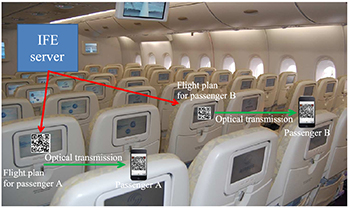
Transmission of the passenger-specific data via 2-D visual codes in an Airbus A330 cabin.
Researchers from Europe have found a way to transmit data to a passenger’s smartphone in-flight without compromising frequency and electromagnetic compatibility regulations or the security of sensitive on-board systems. The optical wireless transmission method involves 2-D visual codes, like the popular black and white QR codes found in magazines (Photon. Res., doi: 10.1364/PRJ.2.000150). According to the researchers, the method is safe because the passenger’s smartphone never directly connects with the on-board system and uses optical transmission that doesn’t interfere with electronic devices.
Some commercial aircraft already offer wireless service to passengers, but it is expensive to install and requires extra maintenance. The team’s proposed optical transmission system takes advantage of preexisting software in each seat’s personal entertainment screens, making it potentially easy and low-cost to integrate. And with optical wireless transmission, passengers do not have to share bandwidth with others. The researchers propose using a sequence of visual codes to transmit passenger-specific information, like connecting flight times and travel plan updates, securely to the individual’s smartphone via the central in-flight entertainment system server. Color codes are used (instead of the standard black and white QR codes) to achieve acceptable data rates of several kilobits per second.
Visual codes are optical representations of data that can be decoded by a scanning device (e.g., a smartphone) with corresponding code readers. They are a convenient way to relay information because of their fast readability, large storage capacity, and because they can contain binary or alphanumeric data. The patterns consist of rows and columns with timing patterns that enable the smartphone to determine the symbol density and code version, and subsequently translate the data into readable file.
In preliminary tests of the system, conducted in a mockup Airbus A330 cabin, both low- and high-end smartphones were able to achieve data rates of up to 120 kbits per second for each individual user. The authors hope to test more colorful and sophisticated visual codes to increase data throughput.
